How to Remove Estrogen from your Drinking Water
So What Is The Ultimate Best Source of Drinking Water?
The Environmental Working Group (EWG) recommends filtered tap water as the number one source of drinking water.
Not only is filtered tap water cleaner than any form of bottled water, it’s also far cheaper for you to live on filtered tap water than on bottled water.
It’s funny how we don’t think twice about forking out a good few dollars per gallon for bottled water (more than the price of gasoline!), and yet wonder if we can handle the financial burden of paying mere pennies per gallon for a standard water filter.
The trouble with water filters is there are hundreds of different makes and models to go for, and the task of selecting the right one for your needs can be pretty daunting. But worry not – they all use a small number of technologies to remove toxins. I’ll tell you about two of the best types of water filter, including something that’s better than any filter, a little later in this article.
Which Water Purification System is Best for Removing Estrogen?
Well reducing estrogen and reducing the feminizing effect of tap water are two different things.
The major types of estrogen found in our water supply include estrone, estradiol, estriol, and the synthetic ethinylestradiol from medications like the oral contraceptive pill. You could just focus on removing these estrogens from your water supply, and a number of studies have focused on exactly that.
The trouble however, is that many of the other more than 100,000 chemicals in wastewater effluent, also have an estrogenic effect on our bodies. These include dihydrofolliculin, octylphenol, nonylphenol, polyethoxylates, trihalomethanes and bisphenol A.
Scientists have also discovered a new class of chemicals that have anti-androgenic (i.e. anti-testosterone) properties. Anti-androgens can be just as feminizing as estrogens.
So rather than look for a water filter that’s just good at removing estrogen, I really think it’s better to look for one that’s good at removing all toxins and impurities in general. This will not only give you water that has a lower feminizing effect on your body, but removing other toxins will be better for your health in general.
Choosing A Water Filter That’s Right For You
There are hundreds of different water filters to choose from. The filter that’s best for you depends on the type of contaminants in your local water supply and your budget.
Your first step is to get a copy of the ‘Water Quality Report’ published annually by your water utility. It may also be called a ‘Consumer Confidence Report’, or just ‘Drinking Water Quality’. You should be able to find it online.
On the report, take note of the pollutants that are close to or exceed the Maximum Contaminant Level (MCL) set by the government (it will say so on the report). When choosing a filter, do your research to make sure it can filter out these particular chemicals.
Activated Carbon Filters

Activated carbon filters are very cost effective, easy to install, and take up very little space. They are effective at removing a wide range of different chemicals including estrogens, but don’t fare so well with dissolved minerals like fluoride.
Advantages
In general, activated carbon filters are your best choice if you are on a tight budget. They remove a wide range of different contaminants, including steroid estrogens and many estrogenic substances like trihalomethanes.
Carbon filters are cheap to buy, cheap and easy to maintain (just one inexpensive cartridge to replace every 6-12 months, or every 1-2 months for water filter pitchers), easy to install, and don’t take up much space.
Disadvantages
Carbon filters are not as thorough as reverse osmosis and distillation (see below). They struggle with toxic metals, and don’t remove mineral-based contaminants like fluoride very well.
Studies show they remove about 80% of estradiol, which is far better than no filter at all, but not as thorough as reverse osmosis and distillation.
Also, the quality of water drops with use of the filter. So if you buy a 2 month filter, you’ll get the purest water in the beginning, and your water will become less and less pure toward the end of that second month.
A Good Choice For An Activated Carbon Filter
I personally started off with a basic water filter pitcher. These are cost-effective and hassle-free, you don’t have to mess around with any plumbing under your sink.
Ideally you’d want to get one that’s made of glass, but I’m yet to find one. The next best thing is to go for a BPA-free plastic one (since BPA is a strong estrogenic chemical that leaches from plastic).
Having tried a few pitchers, I found the following to be best at filtering my water:
Aquagear Water Filter Pitcher (BPA Free)
The Aquagear Water Filter Pitcher removes more contaminants than the leading brand. It takes longer to filter the water through, but that’s only because it’s doing a better job of removing all those estrogenic pollutants.
The Aquagear removes arsenic for example, while most activated carbon based water filters do not.
Compared to other water filter pitchers though, the Aquagear pitcher and replacement filters are bleamin’ expensive. You get what you pay for I guess.
Reverse Osmosis Filters
Reverse osmosis uses high pressure to force water through a membrane with tiny holes that only let water and very small particles through. It will remove some dissolved salts, organic chemicals, bacteria and pyrogens.
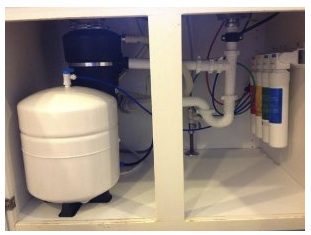
Reverse osmosis filters are very effective at removing impurities from your water. They have to be integrated into your plumbing, and with multiple filters and a storage tank, can take up quite a bit of space.
Advantages
Reverse osmosis (RO) does a great job at removing contaminants that carbon filters don’t, like fluoride, arsenic, nitrates and perchlorate. Most RO filters are combined with a carbon filter, so they end up removing everything a carbon filter does and more.
Disadvantages
As reverse osmosis membranes age, the pores in the membranes become larger and allow more and more impurities to pass through into the treated water. So like with activated carbon filters, the quality of water decreases with use.
High purchase and maintenance cost is another factor. Depending on your model, you are generally advised to replace the reverse osmosis membrane every 2-3 years (though some models last much longer), and multiple (generally 1-5) carbon filter cartridges every 6-12 months.
A LOT of water is wasted as well. Some reverse osmosis filters can waste as much as 10 gallons of water for every 1 gallon of purified water.
Also, you need a plumber to install one of these (although you can do it yourself if you’re a bit of a handy-person), and since it consists of a storage tank, a membrane, and usually multiple filters, it can take up quite a bit of space.
So reverse osmosis filters are better (though not perfect) at removing impurities than activated carbon, but are a lot of hassle to set up, and expensive to maintain.
Good Choices For Reverse Osmosis Filters
1. iSpring RCC7 5-Stage Reverse Osmosis Water Filtration System
This 5-stage filter is reliably thorough in its filtration, being Water Quality Association (WQA) Gold Seal Certified. This means it has been rigorously tested by an independent body, with laboratory tests, literature review and materials assessment.
It removes up to 97.2% of over 1,000 different types of contaminants, including arsenic, asbestos, chlorine, hormones, fluoride, lead, mercury, sodium, bacteria, giardia, and viruses.
It’s also easier to install compared to other reverse osmosis systems, and is backed by a 3-year manufacturer warranty, unlike other companies that only have a 1-year warranty.
You can learn more about this filter in a short review I’ve written about it here:
And you can order it here:
2. Home Master TMHP HydroPerfection Reverse Osmosis Water Filter
The Home Master is more expensive than the iSpring above, but for good reason.
Both produce pure water, though the iSpring is WQA certified and the Home Master is not. But the Home Master has other benefits that may interest you.
It’s designed in a different way from most other reverse osmosis water filters, which allows it to purify water faster, so your water has a faster flow rate (good for washing vegetables, and connecting one filter to multiple outlets like the kitchen sink and the refrigerator).
The Home Master is also easier to maintain with easier filter changes. It wastes less water, is quieter than other reverse osmosis systems, and lasts longer, with fewer leaks and fewer problems in general.
You can learn more about the Home Master in a short review I’ve written about it here:
And you can order it here:
Distillation
This is the gold standard of water purification.
Distillation mimics the hydrological (water) cycle, which NATURE uses to purify water.
In the water cycle, the sun heats up and evaporates water from the ocean. The evaporated water rises, until it cools and condenses to form clouds. It then rains, and the water makes its way back into the ocean through the ground.
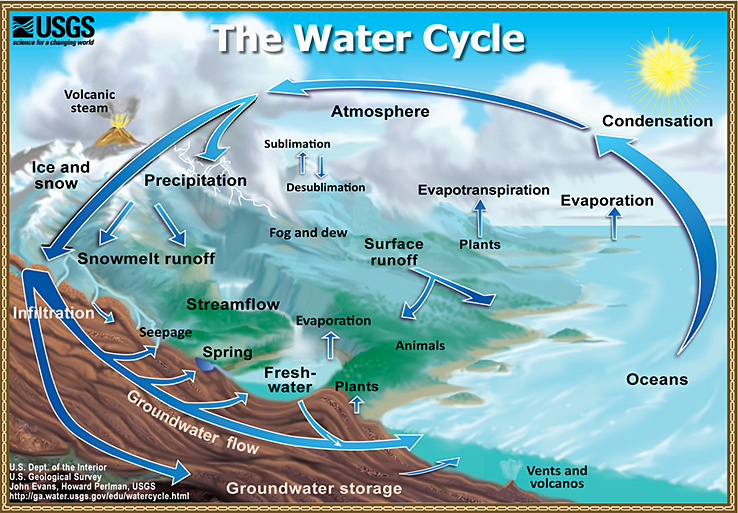
Pure water is made available to us through streams, lakes, and rivers. The higher up in the cycle, the more pure the water is. If it wasn’t for air pollution, rain water would be 99.9% pure.
With a good water distiller, you get the purity of rain water minus the air pollution.
In a distiller, tap water is heated and boiled in a boiling chamber. Purified steam rises up from the contaminated water, leaving the impurities behind. The steam moves into a cooling coil, where it is run over a fan that cools the steam to condense it back into water. From there the purified water flows into a glass jar or stainless steel holding tank.
Unlike with barrier methods (e.g. activated carbon and reverse osmosis) that remove contaminants from the water, distillation removes the water from the contaminants.
Advantages
Distillation purifies water in the same way mother nature’s hydrological system does it. No other system can improve upon the natural processes that govern the hydrological cycle, which has supported life on Earth for billions of years.
Unlike with filters, which lose effectiveness with use, distillation will consistently remove impurities, whether you are using the distiller for the first time, or 10 years later.
Disadvantages
Distillation by itself still doesn’t remove everything. There are some contaminants that have a lower boiling point than water that will rise up with the steam. These are called “volatile organic compounds” (VOC’s).
However, a lot of distillers use a simple filter at the end of the distillation process to get rid of the VOC’s.
Also, I haven’t searched far and wide for one, but there doesn’t seem to be a widely-available water distillation system that you can hook up to your kitchen tap, like you can with reverse osmosis. Since distillation requires water to be boiled then cooled, all of the units I’ve seen so far are separate from your kitchen sink.
Distillation is an energy-intensive process. It takes a lot of energy to boil water. Most units I’ve seen are electrical, though gas units are available too. Either way, expect to be using quite a bit of gas or electricity. Saying that, it’s still cheaper to distill your own water, than it is to buy distilled water from the shops.
Unlike with activated carbon and reverse osmosis filters, you can’t get water on demand with distillation. It takes time for the distillation process to happen, so you’ll have to distill your water in advance. You can overcome this problem with an automatic distiller, but these are a lot more expensive (see #3 below).
——
There are some scaremongers out there (usually water filter manufacturers) who claim distilled water is harmful because distillation removes important minerals like calcium and magnesium. But that’s nonsense, because all you need out of water is water. If your body needs minerals, you get it from your diet. Dark green veggies like broccoli and spinach contain far more calcium and magnesium than any source of water.
There’s also the fact that tap water contains both beneficial organic minerals, and harmful inorganic minerals. Filters have no way of differentiating between the two. So if a filter manufacturer claims their filter leaves beneficial minerals behind in the water, then you can bet they also leave harmful minerals behind too.
Good Choices For Water Distillation Units
1. Countertop Water Distiller
I personally got myself a countertop water distiller just like this one (good UK alternative | good Canada alternative).
It consists of a stainless steel boiling chamber at the bottom, a stainless steel coil-based fan assisted cooling system at the top, and a glass collection jar. Any plastic on the unit is BPA-free, and to be extra safe, the water never touches any plastic.
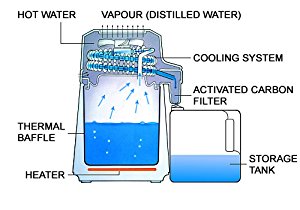
It produces 1 gallon of water in about 5.5 hours, though you can get that gallon a lot faster if you use boiling water to start with.
It also comes with a post-distillation carbon filter, which removes any remaining VOC’s.
To use it, all you do is fill the water chamber with tap water, put the cooling unit over it, position the collection jar, and turn the unit on. Then the fan will come on, and if you used cold water, pure and natural distilled water will start to collect into the collection jar in about 30 minutes. Once the water is all used up, the unit will shut down by itself.
This is one of the smaller distillers out there, and is ideal for single users, couples, and small families.
2. Pure Water Mini-Classic CT Counter Top Distiller
The Pure Water distiller is another small distiller that’s suitable for single users and small families. However, it’s more than twice the price of the countertop distiller above, because of a few distinct advantages:
– It doesn’t boil the water tank dry
With the countertop distiller above, I’ve noticed that when I let it shut off by itself, the machine BURNS the remaining limescale in the wastewater, and the burnt limescale sticks like a black hard muck on the bottom of the beautiful stainless steel tank. This will destroy the stainless steel tank over time. It also means you can end up with lower purity water, because the tank will reach higher temperatures than the boiling temperature of water after all the water is gone.
By shutting off BEFORE all the water has dried up, the Pure Water machine will be easier to clean, it will last longer, and give you purer water.
Maybe this is why they mention a 15 year limited warranty on their website.
– Designed with purity vents
Purity vents in this system allow VOC’s to escape, which means you’ll likely end up with purer water than with a standard countertop distiller.
– It’s made in the USA.
The countertop distiller above is made in China. But hey, it’s still great quality. Don’t forget, the iPhone is made in China too.
Click here to learn more or order the Pure Water distiller (only available in the USA)
3. Durastill 30J 8 Gallon Per Day Automatic Water Distiller
This is an automatic water distiller, which has a bigger tank and higher output than the two distillers above, making it ideal for larger families.
With the above two distillers, you’d get a maximum of 4 gallons of distilled water a day. With this Durastill unit, you’ll get 8 gallons a day.
But that’s not all.
Unlike the two distillers above, an automatic distiller like this one is connected to your water supply, so that it can automatically fill up the reserve tank when the water level is low. This means there’s no need to be home to keep refilling and cleaning the distiller after every use.
Like the Pure Water machine above, the Durastill also has special vents that help VOC’s escape, so your water is ultra-pure.
Other Things You Can Do
In the modern world, we are bombarded by estrogens, estrogen-like particles, and anti-androgens from all directions. They are in the food we eat (in the form of preservatives, flavor enhancers, fertilizers, hormones and more), in the air we breath (from vehicle exhaust fumes and general pollution), and the cosmetics we use on our skin (in the form of parabens and other chemicals).
Although the government and industry will argue there is not direct evidence, there is more than enough indirect evidence to suggest these chemicals are responsible for various cancers and countless diseases and developmental disorders. Studies suggest these chemicals are linked to decreasing sperm counts and testosterone levels in men, and increased incidences of conditions like gynecomastia.
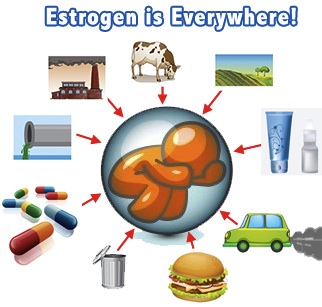
Estrogen is everywhere in the modern world, you’d have to be living in a bubble to avoid it all. But thankfully, you can take specific measures to defend yourself.
You’d have to be living in a bubble to avoid all of the feminizing chemicals in your environment. The least you can do though, is avoid as many as you can.
Getting a water filter, or better, a distiller, is a good start. It’s also important to exercise and make dietary and lifestyle changes.
The right type of exercise (like high intensity interval training and resistance training) can help to combat estrogen by boosting masculine hormones like testosterone and growth hormone.
Eating organic produce and avoiding grains and refined carbohydrates can help to reduce the estrogenic effect on your body. Steaks, organ meats, seafood, nuts’n seeds and the right vegetables can help boost testosterone levels.
If you have man boobs, it’s probably because you have too much exposure to the female hormone estrogen. Filtering or distilling your water is a crucial step in eliminating man boobs, but there’s a hell of a lot more you can do.
https://chestsculpting.com/how-to-remove-estrogen-from-your-drinking-water/
https://chestsculpting.com/how-to-remove-estrogen-from-your-drinking-water/
The How To Lose Man Boobs Naturally Video gives you the lo-down on all the different methods you can use to lose your man boobs by combating excess estrogen, and raising levels of the male hormone testosterone.
By bringing your body’s estrogen to testosterone ratio back into its natural, masculine balance, you will finally see that chest start to flatten out. To learn more, click the following link to watch the video:

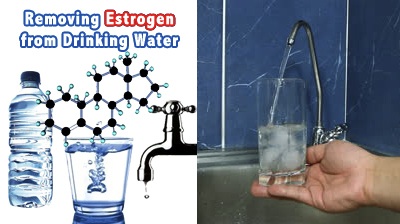
Ei kommentteja:
Lähetä kommentti
You are welcome to show your opinion here!